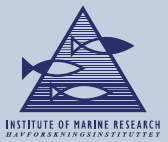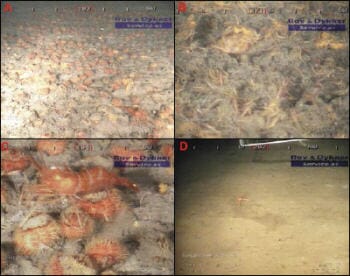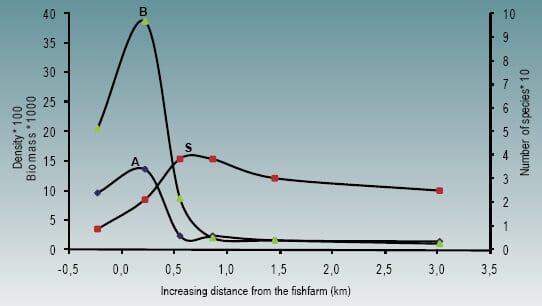
The organic matter released from fish cages can have a significant - and positive - effect on the nutrients available to microbial life. In turn this can support greater bio-diversity, particularly the biomass of benthic fauna, and subsequently larger species such as crustaceans.
A two year study by IMR's Benthic habitat and shellfish research team, has observed the dispersal of organic matter, sedimentation rates and the animals living on the fjord bed within a three km gradient centred on a deep water salmon enterprise on the Hardanger Fjord, in the South Eastern region of Norway.

Still photos taken from an ROV video study of a station 250 metres north (A, B and C) and a station 1500 metres north (D) of the farm’s mooring point one year after the start of production. The images show the high abundance of the sea urchin Brissopsis lyrifera and of small polychaetes within the footprint of the farm, and the desert-like unaffected area of the fjord.
The farm is a medium sized grow out facility producing almost 3,000 tonnes of salmon per cycle. It is moored at a single point, to a depth of 230 metres, and moves with the wind and water currents. The enterprise is estimated to release 300 tonnes of waste organic matter into the fjord per cycle, which is dispersed over an area 30 times greater than the area covered by the sea-cages. At maximum feeding rates, a medium sized salmon farm can emit between 1500 and 3000 kg of waste matter a day - most of which is excreted by the fish, although a small percentage will also be contributed to feed waste
No pollution, only change
The Hardanger site has been producing salmon successfully for ten years, and there is no pollution. However, major changes to the seabed have been observed, particularly large increases to the quantity of benthic fauna (micro organisms). The greatest effect was noted in the 250 metres around the mooring point. Here the sedimentation rates of organic carbon were nine times higher than those measured at points three km further out into the fjord. Interestingly, analysis showed that there was no accumulation of organic matter in the sediment here, although there was an increased abundance of biomass, micro organisms and microscopic animals. It suggests that these organism were feeding off the waste. Also, populations of bristle worms, shellfish and sea urchins were using it as food source.

Abundance (A), biomass (B) and number of benthic species (S) larger than 1 mm from six stations along the 3 km-long gradient away from the salmon farm at peak production (September and December, 2004).
Most of the organic material was spread over the 250 metres surrounding the mooring point. However, the composition of the sediments showed that some of the waste was dispersed as far as 550 to 900 metres beyond this and supported a very high number of benthic species.
The density and biomass of small sediment ingesting animals in this' transitional zone', was fairly low (see figure), but when salmon production was at its peak, there were more than twice as many species here as was in the immediate vicinity of the farm.
From these studies it appears that the benthic food chain can be influenced to distances on the sea or lake bed well beyond the immediate vicinity of the fish farm. This is particularly the case for mobile organisms such as bottom-living fish and crustaceans.
Other research has shown that the waste produced by the salmon farm was also exploited by shrimp (Pandulus borealis). Those caught near the farm during the winter had a higher fatty acid content in their musculature than shrimp caught in adjacent fjords where there was no fish farming activity. It suggests that food resources are more stable throughout the year in waters where aquaculture activity is present.
Commercial and environmental significance
These IMR studies underline the importance of operating fish farms with good dispersal conditions. It also confirms that sea-bed aquatic life can benefit from fish farming, so long as stocking rates are managed so not to 'oversupply' nutrients and cause an environmental imbalance. The population of micro-organisms and animals feeding off the sediments need to be able to cope with the level of material released.With a good location, a high level of production can be maintained over a long period of time without the accumulation of organic matter and with a greatly increased production of benthic fauna.
Further Reading
|
|
- You can view a full article by the IMR by clicking here. |
|
|
- For more information go to the Institute of Marine Research. |
October 2007

